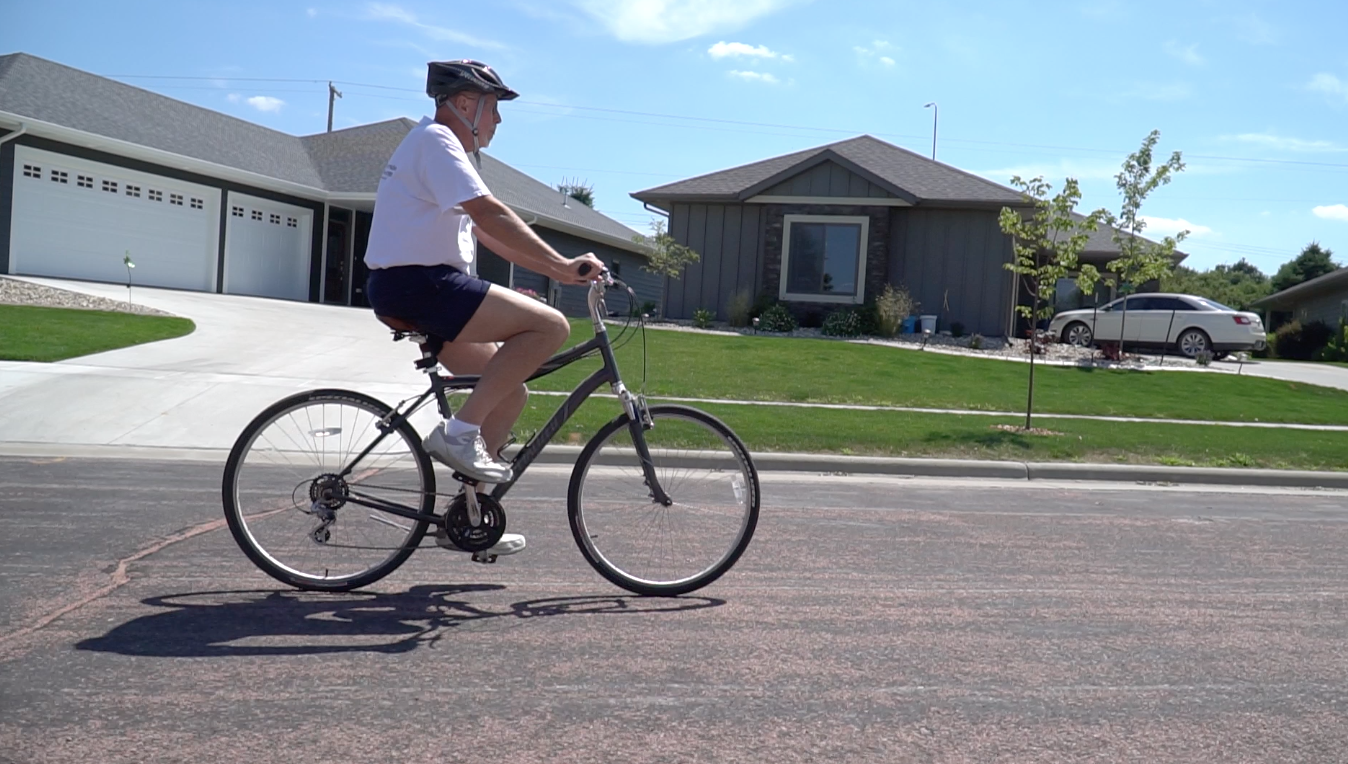Max Merry jumped from behind his desk at his office in Dell Rapids, South Dakota, and showed a visitor one of his favorite parts of life now that he’s sporting a pair of replacement knees.
“The most fun thing about this,” he said as he arose from his chair, “is that it had been years since I had been able to get down and read a putt like this.”
It was an imaginary putt but there was nothing made-up about being able to bend at the knees into a crouch — and then spring back up.
By itself, getting a more accurate view of a golf shot would not qualify as life-changing for most of us. For Merry, though, it’s an indication that he’s been able to improve his quality of life by the surgical replacement of his two knees.
Brian Aamlid, a Sanford Health orthopedic surgeon specializing in total knee and hip joint replacements, performed the surgeries on Merry’s knees, three months apart, in 2014. Dr. Aamlid’s efforts figure prominently for what ultimately became a success story. The patient will enthusiastically tell you that, but more importantly in this case, he can also show you.
“I’d forgotten what it was like to get down like that to read a putt,” Merry said. “I’m not steady enough to get behind the plate and catch anymore, but I can read putts.”
Active all the time
He goes for bicycle rides with his wife Cheryl after work, he walks his rounds of golf and he spends a lot of time pushing himself to the limits on exercise machines. He lives the active life he was hoping to live as a 69-year-old. This is in spite of the fact that neither of the knees this attorney was born with were going to let him do that.
“I’m much more than a satisfied customer,” Merry said.
He had his first major knee surgery as a teenager in 1964 after suffering cartilage and ligament damage competing in sports. Arthritis showed up in his 30s and 40s. Increasingly as he got older, physical activities he’d once taken for granted became more and more uncomfortable.
Inevitably, there came a time when conventional measures short of joint replacement were no longer going to do much good. It was a journey many in Merry’s situation experience. It can be difficult to acknowledge one’s knees are out of options but the reality of that fact can take the suspense out of deciding what comes next.
“We try to take people through a process of exhausting non-operative measures,” Dr. Aamlid said. “That can happen over a number of years. From oral medications to braces to therapy to injections. You go as far as you can with that. Once you get to the point where those aren’t working anymore the patients will say, ‘I want to move on. I’m not in a good place. These measures aren’t really working anymore.’ They’ve come to the conclusion that an operation is the way to go.”
Merry prepares for new knees
Merry had definitely reached that stage.
“As the years went along, I knew I was going to have to do something further with that knee,” Merry said. “I got into my upper 30s and early 40s and the arthritis was there. And then as I got older it got worse.”
He was surprised to learn after a visit with Dr. Aamlid that his right knee was actually in tougher shape than his left, though his left hurt more. In the end, the only real decision was figuring which he was going to get done first and how much time he’d wait between surgeries.
He replaced his right knee at the end of July and had the left one done in October. Expediting his recovery was that he scrupulously followed Dr. Aamlid’s advice leading up to the surgeries.
“What helped my anxiety level is that I went into that first surgery feeling as prepared for it as a 64-year-old could,” Merry said. “I was in very good physical condition. I did all the things Brian told me to do.”
The result? On a recent visit to the Merry home in Dell Rapids, a video crew put him through a knee-replacement Olympics of sorts. He walked to Dell Rapids’ Rocky Run Golf Course behind his house and hit golf shots. Then he rode his bicycle up and down the street. He even mowed a portion of the lawn.
None of it would have been possible without new knees.
A success story
“The way Mr. Merry progressed through this is the way we hope everybody progresses through this,” Dr. Aamlid said. “It’s the way we would like everybody to progress. Most people do but it’s not 100 percent. Everything came together as one would design. It’s an incredibly gratifying thing to see the process play out like it did. When a plan comes together it’s a beautiful thing.”
Both Merry and Dr. Aamlid are quick to point out this was a team effort involving commitment and communication.
It started with the positive attitude of the patient, Dr. Aamlid said. Two new knees and five years later, there’s no reason to replace that.
“Everybody has their role in this whole process but there is also data that says basically that glass-is-half-full people do better than glass-is-half-empty people,” Dr. Aamlid said. “When you meet Mr. Merry, it doesn’t take you long to figure out that he approaches life with a glass that is more than half full. That part of it is just that — it’s how he lives his life. Every orthopedic surgeon would like to work with a hundred Max Merrys.”
More stories
- Total knee replacement with a new robot assistant
- Life after knee replacement surgery: A tale of two knees
- Knee replacement gives retired military vet new mobility
…
Posted In Healthy Living, Orthopedics

